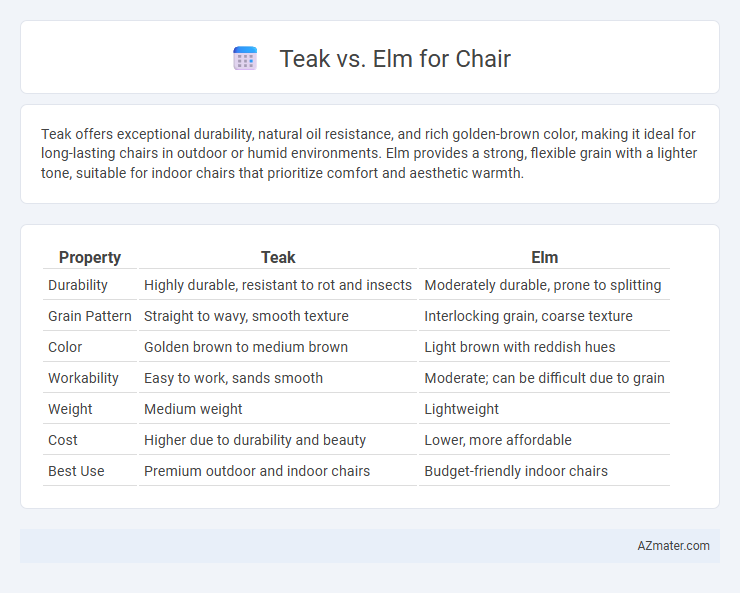Teak offers exceptional durability, natural oil resistance, and rich golden-brown color, making it ideal for long-lasting chairs in outdoor or humid environments. Elm provides a strong, flexible grain with a lighter tone, suitable for indoor chairs that prioritize comfort and aesthetic warmth.
Table of Comparison
| Property | Teak | Elm |
|---|---|---|
| Durability | Highly durable, resistant to rot and insects | Moderately durable, prone to splitting |
| Grain Pattern | Straight to wavy, smooth texture | Interlocking grain, coarse texture |
| Color | Golden brown to medium brown | Light brown with reddish hues |
| Workability | Easy to work, sands smooth | Moderate; can be difficult due to grain |
| Weight | Medium weight | Lightweight |
| Cost | Higher due to durability and beauty | Lower, more affordable |
| Best Use | Premium outdoor and indoor chairs | Budget-friendly indoor chairs |
Introduction to Teak and Elm Wood
Teak wood, renowned for its exceptional durability and natural resistance to decay and pests, features a rich golden-brown hue that darkens with age, making it a premium choice for long-lasting chairs. Elm wood, prized for its interlocking grain and flexibility, offers a unique combination of strength and shock resistance, characterized by a creamy tan to reddish-brown color that adds warmth and character to furniture. Both woods provide distinct advantages for chair construction, with teak excelling in outdoor durability and elm favored for its ergonomic comfort and indoor aesthetic appeal.
Origins and Availability
Teak wood, primarily sourced from Southeast Asia, boasts natural oils that enhance its durability and water resistance, making it a premium choice for high-end chair manufacturing. Elm, native to Europe and North America, offers a strong, interlocking grain structure that resists splitting, commonly found in rustic or traditional furniture. Availability of teak is more limited and often sustainably harvested due to environmental regulations, whereas elm remains widely accessible with fewer restrictions impacting its supply.
Appearance and Grain Patterns
Teak chairs exhibit a rich, golden-brown color with a smooth, straight grain that often features fine lines and occasional wavy patterns, creating a luxurious and warm aesthetic. Elm chairs display a lighter, medium brown hue with prominent, interlocking grain patterns and varying textures that add visual interest and rustic charm. Both woods offer distinct and attractive appearances, with teak leaning toward elegance and durability, while elm provides a more textured and natural look.
Strength and Durability
Teak offers exceptional strength and durability due to its high oil content and dense grain, making it highly resistant to moisture, decay, and insect damage, ideal for long-lasting chairs. Elm wood, while also strong and shock-resistant, is slightly less durable than teak and more susceptible to moisture, which may lead to warping over time. Chairs crafted from teak generally require less maintenance and provide superior longevity, especially in outdoor or high-use environments.
Resistance to Weather and Pests
Teak is highly resistant to weather and pests due to its natural oils and dense grain, making it an ideal choice for outdoor chairs that endure moisture and insect exposure. Elm offers moderate resistance but is more prone to decay and insect damage when compared to teak, requiring regular maintenance for outdoor use. The superior durability and low maintenance of teak enhance its longevity in harsh environmental conditions, outperforming elm in outdoor furniture applications.
Maintenance and Care Requirements
Teak chairs require minimal maintenance due to their natural oil content, which resists moisture, pests, and decay, making them ideal for outdoor use with only occasional cleaning and oiling to maintain their rich color. Elm chairs, while durable, need more frequent care such as regular polishing and protection from excessive moisture to prevent warping and cracking. Proper maintenance ensures the longevity of both types, but teak's inherent resistance results in lower upkeep compared to elm.
Comfort and Ergonomics
Teak chairs offer superior comfort due to their natural oils that enhance wood flexibility and smoothness, making them ideal for long-term seating. Elm wood provides excellent ergonomic support with its interlocking grain structure, which contributes to durability and slight cushioning under pressure. Both woods balance aesthetics and functionality but teak's natural resistance to wear and moisture gives it an edge in maintaining comfort over time.
Sustainability and Environmental Impact
Teak is highly valued for its natural oils and durability, making it resistant to pests and decay, which extends the life of chairs and reduces the need for frequent replacement, contributing positively to sustainability. Elm, often sourced from managed forests with faster growth rates, offers an environmentally friendly option due to its carbon sequestration during growth and lower harvesting impact. Choosing FSC-certified teak or elm ensures responsible forest management, minimizing deforestation and promoting long-term ecological balance in chair production.
Cost Comparison
Teak chairs typically cost more than elm chairs due to teak's superior durability, natural resistance to weather, and rich oily texture that deters pests. Elm is more affordable as it is widely available and easier to work with, though it lacks the longevity and moisture resistance of teak. For budget-conscious buyers, elm offers a cost-effective option without sacrificing moderate durability, while teak is preferred for long-term investment despite higher initial costs.
Choosing the Best Wood for Your Chair
Teak offers exceptional durability and natural resistance to moisture and pests, making it ideal for chairs in both indoor and outdoor settings. Elm is prized for its attractive grain and flexibility, providing comfort through gentle springiness in chair designs. The decision between teak and elm hinges on your priority for longevity and weather resistance versus aesthetic appeal and seating comfort.

Infographic: Teak vs Elm for Chair
 azmater.com
azmater.com